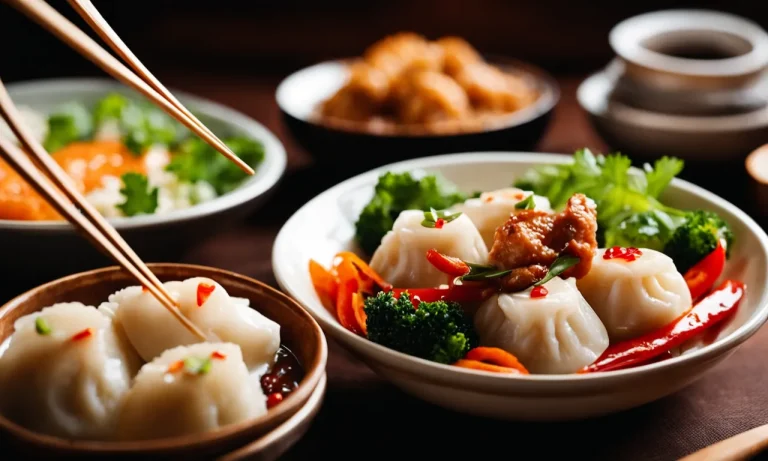Hotpot restaurants have become increasingly popular in recent years, offering a unique and interactive dining experience unlike any other. If you’re wondering what exactly a hotpot restaurant is and what makes it so special, you’ve come to the right place.
In short, a hotpot restaurant is a restaurant where guests cook their own food in boiling pots of soup or broth at their table. Hotpot is a traditional Chinese meal, but it has spread in popularity across the world.
In this comprehensive guide, we’ll explore everything you need to know about hotpot restaurants. We’ll cover the origins of hotpot, what a typical hotpot dining experience is like, the different broths and ingredients you’ll find, tips for getting the most out of your hotpot meal, and the health benefits of this interactive cooking method.
The History and Origins of Hotpot
Hotpot, also known as steamboat, is a popular dining experience that originated in China. It is a communal meal where diners gather around a simmering pot of broth and cook a variety of ingredients. The history of hotpot can be traced back thousands of years, making it a cherished tradition in Chinese cuisine.
Hotpot’s Chinese Roots
The roots of hotpot can be found in ancient Chinese cooking practices. It is believed that the concept of hotpot was first introduced during the Tang Dynasty (618-907 AD). Back then, it was a way to cook and share food among nomadic tribes.
The use of a simmering pot of broth allowed for the preservation of food and provided warmth during the cold winter months.
Hotpot has evolved over time, with different regions in China adding their own unique flavors and ingredients. Sichuan hotpot, for example, is known for its spicy and numbing broth, while Mongolian hotpot features thinly sliced lamb and a rich bone broth.
Spreading Across Asia
As hotpot gained popularity in China, it also spread to other parts of Asia. Countries like Japan, Korea, and Thailand have their own versions of hotpot, each with its own distinct flavors and cooking styles.
In Japan, hotpot is known as shabu-shabu and is often enjoyed with thinly sliced beef and a variety of vegetables. In Korea, hotpot is called jeongol and is typically served with a spicy broth and a variety of seafood.
Gaining Popularity Worldwide
In recent years, hotpot has gained popularity worldwide, with hotpot restaurants opening up in major cities across the globe. This can be attributed to the rise of social media and the increasing interest in global cuisines.
Hotpot’s popularity can also be attributed to its interactive nature and the communal dining experience it provides. It allows friends and family to gather around a table and cook their own food, creating a fun and engaging atmosphere.
With the rise of hotpot’s popularity, there are now hotpot variations to suit different dietary preferences, such as vegetarian and seafood options. This ensures that everyone can enjoy the hotpot experience, regardless of their dietary restrictions.
The Hotpot Restaurant Dining Experience
Hotpot restaurants offer a unique and interactive dining experience that has gained popularity around the world. This style of dining originated in China and has since spread to various countries, captivating food enthusiasts with its communal and customizable nature.
At a hotpot restaurant, guests gather around a table equipped with a built-in stove or induction cooker, where they can cook their own food right at the table.
Cooking at Your Table
One of the main highlights of dining at a hotpot restaurant is the opportunity to cook your own food at the table. Each table is equipped with a pot filled with simmering broth, which serves as the base for cooking.
Guests can choose from a variety of ingredients, such as thinly sliced meats, fresh seafood, vegetables, and noodles, which they then cook in the hot broth. This interactive cooking experience allows diners to control the cooking time and create personalized dishes to suit their tastes.
Choosing Your Broth
The choice of broth is an important aspect of the hotpot dining experience. Hotpot restaurants typically offer a range of broth options, including spicy, mild, or herbal broths. Spicy broths are often favored by those who enjoy a kick of heat, while mild broths are more suitable for those who prefer a milder flavor.
Herbal broths, on the other hand, are known for their aromatic and medicinal properties. Some hotpot restaurants even offer split pots, allowing guests to enjoy multiple broths in one sitting.
Selecting Proteins and Vegetables
Hotpot restaurants offer a wide selection of proteins and vegetables for diners to choose from. This includes various types of meats, such as beef, lamb, pork, and chicken, as well as an assortment of seafood options like shrimp, fish, and shellfish.
Vegetables like leafy greens, mushrooms, tofu, and bean sprouts are also commonly available. The diverse array of ingredients ensures that there is something for everyone, regardless of dietary preferences or restrictions.
Dipping Sauces
Complementing the flavors of the cooked ingredients, hotpot restaurants provide an array of dipping sauces to enhance the taste of the food. These sauces can be customized according to personal preferences and can include ingredients such as soy sauce, sesame oil, chili paste, garlic, and cilantro.
Mixing and matching different sauces allows diners to create unique and flavorful combinations that elevate the overall dining experience.
Hotpot restaurants have become popular for their interactive and customizable dining experience. Whether you’re a fan of spicy broths or prefer a milder flavor, hotpot restaurants offer something for everyone.
So gather your friends or family, head to a hotpot restaurant, and enjoy the fun of cooking and sharing a delicious meal together!
Common Hotpot Broths and Ingredients
Popular Broth Bases
When it comes to hotpot, the broth is the foundation of the whole dining experience. Hotpot restaurants offer a variety of broth bases to choose from, each with its own unique flavor profile. Some of the most popular broth bases include:
- Spicy Sichuan broth: Known for its fiery and numbing flavor, this broth is made with a combination of chili peppers, Sichuan peppercorns, and various spices.
- Mild chicken broth: A lighter option, this broth is made by simmering chicken bones and vegetables, resulting in a savory and comforting flavor.
- Mushroom broth: Perfect for vegetarian hotpot lovers, this broth is made by simmering a variety of mushrooms, giving it a rich and earthy taste.
- Tomato broth: Tangy and refreshing, this broth is made by cooking tomatoes with garlic, onions, and herbs, creating a flavorful and slightly acidic base.
Meats and Seafood
One of the highlights of a hotpot meal is the wide range of meats and seafood that you can cook in the bubbling broth. From thinly sliced beef and tender lamb to succulent shrimp and fresh fish fillets, hotpot restaurants offer an array of options to satisfy every meat and seafood lover’s cravings.
According to a study conducted by Food Network, beef and shrimp are the most popular choices for hotpot. These proteins not only add flavor to the broth but also provide a satisfying and protein-rich component to the meal.
Vegetables and Tofu
To balance out the richness of the meats and seafood, hotpot restaurants also offer a wide selection of vegetables and tofu. From leafy greens like spinach and bok choy to crunchy mushrooms and bean sprouts, these ingredients add freshness and texture to the hotpot experience.
Tofu, in particular, is a staple in hotpot and comes in various forms such as silken tofu, firm tofu, and tofu skin.
Noodles and Dumplings
No hotpot meal is complete without noodles and dumplings. These carb-loaded delights not only provide a filling element to the meal but also soak up the flavorful broth. Common options include rice noodles, glass noodles, and wheat noodles.
Dumplings, on the other hand, come in different shapes and fillings, such as pork, shrimp, and vegetable.
According to a recent survey by Eater, rice noodles and pork dumplings are the top choices among hotpot enthusiasts. So make sure to save some room for these delectable additions to your hotpot feast.
Tips for Enjoying Your Hotpot Meal
Go with a Group
One of the best ways to enjoy a hotpot meal is to go with a group of friends or family. Hotpot is a communal dining experience, where everyone gathers around a simmering pot of broth and cooks their own ingredients.
Going with a group allows you to try a wider variety of ingredients and share the experience together. Plus, it’s a great opportunity to bond and have fun!
Pace Yourself
When it comes to hotpot, it’s important to pace yourself. With so many delicious ingredients to choose from, it can be tempting to overindulge. However, hotpot is meant to be enjoyed slowly, savoring each bite. Take your time and enjoy the flavors and textures of each ingredient.
Don’t rush through your meal – hotpot is all about the experience!
Be Strategic
Hotpot restaurants typically offer a wide range of ingredients, from meats and vegetables to noodles and dumplings. To make the most of your hotpot experience, be strategic in your choices. Start with lighter ingredients such as vegetables and tofu, and gradually move on to heartier options like meats and seafood.
This allows the flavors to build and ensures that you don’t fill up too quickly.
If you’re unsure about what to choose, don’t be afraid to ask the staff for recommendations. They are usually more than happy to help you navigate the menu and suggest the best combinations.
Observe Etiquette
While hotpot is a casual dining experience, there are still some etiquette rules to keep in mind. Avoid using your personal chopsticks or utensils to pick up ingredients from the communal pot – instead, use the shared ladles and tongs provided.
Also, it’s considered polite to cook your ingredients fully before eating them, especially when it comes to meats and seafood.
Additionally, be mindful of others at the table and avoid hogging the ingredients or monopolizing the pot. Hotpot is meant to be a shared experience, so make sure everyone gets a chance to enjoy the meal.
Remember, hotpot is not just a meal, it’s an experience. So gather your friends or family, pace yourself, make strategic choices, and observe the etiquette. Enjoy the delicious flavors and the joy of cooking your own meal together!
The Health Benefits of Hotpot
Hotpot is not only a delicious and satisfying meal, but it also offers numerous health benefits. From being lower in calories to providing more nutrients and promoting sharing, hotpot is a great choice for those looking for a nutritious and enjoyable dining experience.
Lower in Calories
One of the main health benefits of hotpot is that it is generally lower in calories compared to other types of meals. The cooking method involves boiling ingredients in a flavorful broth, which means that there is no need for excessive amounts of oil or high-fat ingredients.
This makes hotpot a great option for those who are watching their calorie intake or trying to maintain a healthy weight.
More Nutrients
Hotpot is often packed with a wide variety of ingredients, including fresh vegetables, lean meats, and seafood. This means that you can get a wide range of nutrients in one meal. Vegetables like spinach, cabbage, and mushrooms are rich in vitamins and minerals, while lean meats like chicken and beef provide protein.
Seafood like fish and shrimp are a great source of omega-3 fatty acids. So, by enjoying a hotpot meal, you can easily boost your nutrient intake.
Promotes Sharing
Hotpot is not just about the food, but also about the experience of sharing a meal with friends and family. Sitting around a hotpot table and cooking together creates a sense of community and encourages conversation and bonding.
This social aspect of hotpot dining has been shown to have positive effects on mental well-being. Sharing a hotpot meal not only nourishes the body but also nourishes the soul.
According to a study published in the Journal of Health Psychology, people who regularly share meals with others tend to have lower rates of depression and anxiety. So, next time you’re thinking about where to go for dinner, consider a hotpot restaurant for a healthy and enjoyable dining experience.
Conclusion
Hotpot offers a unique, interactive dining experience where you become the chef. The build-your-own meal style allows you to cater the ingredients to your own taste preferences. Dining on hotpot is also a social affair, bringing families and friends together over a bubbling pot.
If you enjoy cooking and eating healthy, flavorful foods, hotpot is definitely a meal you need to try for yourself.
This guide covered all the origins, ingredients, etiquette tips, and health benefits you need to appreciate hotpot culture. Next time you see a hotpot restaurant in your neighborhood or while traveling, don’t be afraid to give it a try.
Gather some friends and go cook up your own delicious hotpot masterpiece.






